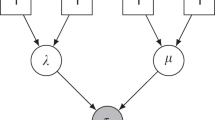Abstract
We describe the reconstruction of a phylogeny for a set of taxa, with a character-based cladistics approach, in a declarative knowledge representation formalism, and show how to use computational methods of answer set programming to generate conjectures about the evolution of the given taxa. We have applied this computational method in two domains: to historical analysis of languages, and to historical analysis of parasite-host systems. In particular, using this method, we have computed some plausible phylogenies for Chinese dialects, for Indo-European language groups, and for Alcataenia species. Some of these plausible phylogenies are different from the ones computed by other software. Using this method, we can easily describe domain specific information (e.g. temporal and geographical constraints), and thus prevent the reconstruction of some phylogenies that are not plausible.
Preview
Unable to display preview. Download preview PDF.
Similar content being viewed by others
References
Brooks, D.R., Mayden, R.L., McLennan, D.A.: Phylogeny and biodiversity: Conserving our evolutionary legacy. Trends in Ecology and Evolution 7, 55–59 (1992)
Brooks, D.R., McLennan, D.A.: Phylogeny, Ecology, and Behavior: A Research Program in Comparative Biology. Univ. Chicago Press, Chicago (1991)
Camin, J.H., Sokal, R.R.: A method for deducing branching sequences in phylogeny. Evolution 19, 311–326 (1965)
Chandler, R.M.: Phylogenetic analysis of the alcids. PhD thesis, University of Kansas (1990)
Day, W.H.E., Sankoff, D.: Computational complexity of inferring phylogenies by compatibility. Systematic Zoology 35(2), 224–229 (1986)
Dyen, I., Kruskal, J.B., Black, P.: An Indoeuropean classification: a lexicostatistical experiment. Transactions of the American Philosophical Society 82, 1–132 (1992)
Edwards, A.W.F., Cavalli-Sforza, L.L.: Reconstruction of evolutionary trees. In: Phenetic and Phylogenetic Classification, pp. 67–76 (1964)
Erdem, E., Lifschitz, V.: Tight logic programs. TPLP 3(4-5), 499–518 (2003)
Erdem, E., Lifschitz, V., Nakhleh, L., Ringe, D.: Reconstructing the evolutionary history of Indo-European languages using answer set programming. In: Dahl, V., Wadler, P. (eds.) PADL 2003. LNCS, vol. 2562, pp. 160–176. Springer, Heidelberg (2002)
Erdem, E., Lifschitz, V., Ringe, D.: Temporal phylogenetic networks and answer set programming. In: Progress (2004)
Erdoğan, S.T., Lifschitz, V.: Definitions in answer set programming. In: Proc. of LPNMR, pp. 114–126 (2004)
Felsenstein, J.: Numerical methods for inferring evolutionary trees. The Quarterly Review of Biology 57, 379–404 (1982)
Felsenstein, J.: PHYLIP (Phylogeny inference package) version 3.6
Foulds, L.R., Graham, R.L.: The Steiner tree problem in Phylogeny is NP-complete. Advanced Applied Mathematics 3, 43–49 (1982)
Gelfond, M., Lifschitz, V.: The stable model semantics for logic programming. In: Proc. of ICLP/SLP, pp. 1070–1080 (1988)
Gelfond, M., Lifschitz, V.: Classical negation in logic programs and disjunctive databases. New Generation Computing 9, 365–385 (1991)
Hennig, W.: Grundzuege einer Theorie der Phylogenetischen Systematik. Deutscher Zentralverlag (1950)
Hoberg, E.P.: Evolution and historical biogeography of a parasite-host assemblage: Alcataenia spp (Cyclophyllidea: Dilepididae) in Alcidae (Chradriiformes). Canadian Journal of Zoology 64, 2576–2589 (1986)
Hoberg, E.P.: Congruent and synchronic patterns in biogeography and speciation among seabirds, pinnipeds, ans cestodes. J. Parasitology 78(4), 601–615 (1992)
Lierler, Y., Maratea, M.: Cmodels-2: SAT-based answer sets solver enhanced to non-tight programs. In: Lifschitz, V., Niemelä, I. (eds.) LPNMR 2004. LNCS (LNAI), vol. 2923, pp. 346–350. Springer, Heidelberg (2003)
Lifschitz, V.: Answer set programming and plan generation. AIJ 138, 39–54 (2002)
Lifschitz, V.: Introduction to answer set programming. Unpublished draft (2004)
Lloyd, J.: Foundations of Logic Programming. Springer, Heidelberg (1984)
Mair, V.H.: The Bronze Age and Early Iron Age Peoples of Eastern Central Asia. Institute for the Study of Man, Washington (1998)
Mallory, J.P.: In Search of the Indo-Europeans. Thames and Hudson, London (1989)
Marek, V., Truszczyński, M.: Stable models and an alternative logic programming paradigm. In: The Logic Programming Paradigm: a 25-Year Perspective, pp. 375–398 (1999)
Minett, J.W., Wang, W.S.-Y.: On detecting borrowing: distance-based and character-based approaches. Diachronica 20(2), 289–330 (2003)
Moskewicz, M.W., Madigan, C.F., Zhao, Y., Zhang, L., Malik, S.: Chaff: Engineering an efficient SAT solver. In: Proc. of DAC (2001)
Nakhleh, L., Ringe, D., Warnow, T.: Perfect phylogenetic networks: A new methodology for reconstructing the evolutionary history of natural languages. In: Language (2005) (to appear)
Rexova, K., Frynta, D., Zrzavý, J.: Cladistic analysis of languages: Indo-European classification based on lexicostatistical data. Cladistics 19, 120–127 (2003)
Ringe, D., Warnow, T., Taylor, A.: Indo-European and computational cladistics. Transactions of the Philological Society 100(1), 59–129 (2002)
Roberts, R.G., Jones, R., Smith, M.A.: Thermoluminescence dating of a 50,000-year-old human occupation site in Northern Australia. Science 345, 153–156 (1990)
Simons, P., Niemelä, I., Soininen, T.: Extending and implementing the stable model semantics. AIJ 138, 181–234 (2002)
Swofford, D.L.: PAUP* (Phylogenetic analysis under parsimony) version 4.0
White, J.P., O’Connell, J.F.: A Prehistory of Australia, New Guinea, and Sahul. Academic Press, New York (1982)
Author information
Authors and Affiliations
Editor information
Editors and Affiliations
Rights and permissions
Copyright information
© 2005 Springer-Verlag Berlin Heidelberg
About this paper
Cite this paper
Brooks, D.R., Erdem, E., Minett, J.W., Ringe, D. (2005). Character-Based Cladistics and Answer Set Programming. In: Hermenegildo, M.V., Cabeza, D. (eds) Practical Aspects of Declarative Languages. PADL 2005. Lecture Notes in Computer Science, vol 3350. Springer, Berlin, Heidelberg. https://doi.org/10.1007/978-3-540-30557-6_5
Download citation
DOI: https://doi.org/10.1007/978-3-540-30557-6_5
Publisher Name: Springer, Berlin, Heidelberg
Print ISBN: 978-3-540-24362-5
Online ISBN: 978-3-540-30557-6
eBook Packages: Computer ScienceComputer Science (R0)




